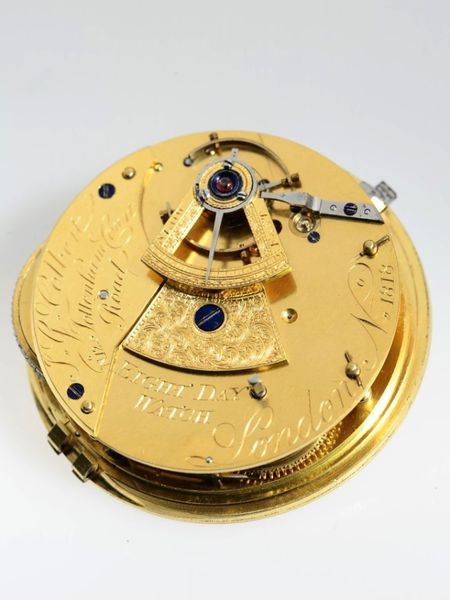Datei:J.G. Colbert, Nr. 1818, circa 1817 (4).jpg

Originaldatei (641 × 854 Pixel, Dateigröße: 114 KB, MIME-Typ: image/jpeg)
J.G. Colbert, No. 12 Tottenham Court Road, London, Werk Nr. 1818, 64 mm, 191 g, circa 1817

|
Alle Bildrechte liegen bei dem Auktionshaus Auktionen Dr. H. Crott. Diese Abbildung ist urheberrechtlich geschützt und steht nicht unter einer freien Lizenz. Für anderweitige Nutzungen außerhalb von Watch-Wiki ist die schriftliche Zustimmung des Urheberrechtsinhabers nötig. |
Seltene, interessante englische Taschenuhr mit 8 Tagen Gangreserve und Duplexhemmung Geh.: Silber, glatt, Gehäusemacher-Punzzeichen "HM". Ziffbl.: Email, radiale röm. Stunden, kleine Sekunde, signiert, Spade-Goldzeiger. Werk: Messing-Vollplatinenwerk, vergoldet, Kette/Schnecke, nummeriert, signiert "EIGHT DAY WATCH", verschraubte Chatons, profilierte Werkspfeiler, Duplexhemmung, kleine bimetallische "Z"-Unruh mit 4 Schrauben, floral gravierter Unruhkloben mit segmentförmigem Ausschnitt für Regulierung.
A rare and interesting English pocket watch with 8 day power reserve and duplex escapement Case: silver, polished, case maker's punch mark "HM". Dial: enamel, radial Roman hours, auxiliary seconds, signed, gold spade hands. Movm.: brass full plate movement, gilt, chain/fusee, numbered, signed "EIGHT DAY WATCH", screwed chatons, moulded movement pillars, duplex escapement, small bimetallic "Z" balance with 4 screws, florally engraved balance cock with segment-shaped cutting for regulation.
J.G.I. Colbert was a member of the Clockmakers' Company and worked first at 12 Tottenham Court Road (between Regents Park and Russell Square) and later at Grafton Street near Berkeley Square. He was very likely an immigrant watchmaker from France or the French speaking regions of Switzerland; his name and the fact that the watches wind through the dial - which is typically French - strongly indicate this. The marks are too faint to enable us to determine the maker of the silver case. The maker of the pendant - who may have created the case too - was Michael Atkins at 4 Red Lion Street in Clerkenwell; his mark was registered on February 1, 1813.
The duplex escapement used in this watch is based on designs by Baptiste Dutertre, who had developed the fundamental concepts around 1724. Pierre Le Roy converted the designs into a workable escapement mechanism in the 1850s; in the first half of the 19th century the duplex escapement was quite frequently used in England for high quality watches; it was eventually replaced by the chronometer and lever escapements, which performed even better.
Dateiversionen
Klicke auf einen Zeitpunkt, um diese Version zu laden.
| Version vom | Vorschaubild | Maße | Benutzer | Kommentar | |
|---|---|---|---|---|---|
| aktuell | 11:26, 23. Apr. 2015 |  | 641 × 854 (114 KB) | Andriessen (Diskussion | Beiträge) | J.G. Colbert, No. 12 Tottenham Court Road, London, Werk Nr. 1818, 64 mm, 191 g, circa 1817 {{Bildrechte U|dem Auktionshaus Auktionen Dr. H. Crott}} Seltene, interessante englische Taschenuhr mit 8 Tagen Gangreserve und Duplexhemmung Geh.: Silber… |
Du kannst diese Datei nicht überschreiben.
Dateiverwendung
Keine Seiten verwenden diese Datei.